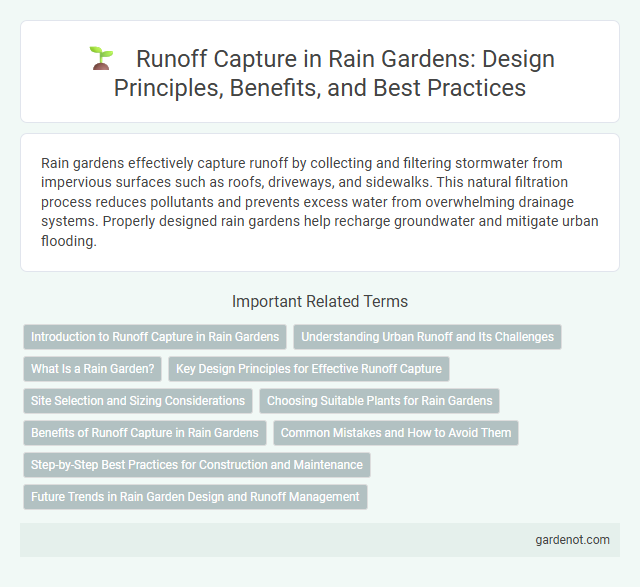Rain gardens effectively capture runoff by collecting and filtering stormwater from impervious surfaces such as roofs, driveways, and sidewalks. This natural filtration process reduces pollutants and prevents excess water from overwhelming drainage systems. Properly designed rain gardens help recharge groundwater and mitigate urban flooding.
Introduction to Runoff Capture in Rain Gardens
Rain gardens effectively capture stormwater runoff by allowing water from impervious surfaces like roofs and driveways to infiltrate the soil rather than flowing directly into storm drains. This process reduces pollution, decreases flooding risk, and replenishes groundwater supplies. Engineered with native plants and permeable soil layers, rain gardens enhance runoff capture by slowing water flow and promoting absorption.
Understanding Urban Runoff and Its Challenges
Urban runoff consists of rainwater or melted snow that flows over impervious surfaces such as roads, roofs, and sidewalks, collecting pollutants like oils, heavy metals, and sediments. This rapid runoff leads to increased flooding, erosion, and degradation of water quality in local waterways. Effective rain garden design captures and infiltrates urban runoff, reducing pollution loads and mitigating stormwater challenges in densely developed areas.
What Is a Rain Garden?
A rain garden is a shallow planted depression designed to capture and absorb runoff from impervious surfaces such as roofs, driveways, and sidewalks. It reduces stormwater runoff by allowing water to infiltrate the soil, which filters pollutants and replenishes groundwater. These gardens typically feature native plants that thrive in wet conditions and improve water quality by slowing and treating runoff.
Key Design Principles for Effective Runoff Capture
Runoff capture in rain garden design hinges on strategic placement and soil permeability to maximize infiltration and minimize surface water runoff. Incorporating native vegetation with deep root systems enhances water absorption and reduces erosion, while sizing the rain garden according to the watershed area ensures adequate capacity for peak storm events. Proper grading and overflow pathways prevent flooding and optimize the garden's ability to manage stormwater sustainably.
Site Selection and Sizing Considerations
Rain garden site selection requires analyzing soil permeability, slope, and proximity to structures to optimize runoff capture and prevent water pooling near foundations. Sizing considerations depend on the catchment area and average rainfall intensity, ensuring the garden can infiltrate at least 0.5 to 1 inch of runoff per storm event. Proper dimensioning enhances stormwater management, reduces erosion, and improves groundwater recharge.
Choosing Suitable Plants for Rain Gardens
Selecting plants with deep root systems and high water absorption capacity enhances runoff capture in rain gardens, ensuring efficient infiltration and reducing surface water. Native species such as sedges, rushes, and wetland wildflowers are ideal due to their adaptability to local rainfall patterns and soil conditions. Incorporating a diverse plant palette increases resilience against drought and flooding while optimizing nutrient uptake from runoff.
Benefits of Runoff Capture in Rain Gardens
Rain gardens effectively capture runoff by intercepting rainwater from impervious surfaces, reducing stormwater volume and peak flow rates. This process minimizes erosion, decreases pollutant loads in nearby water bodies, and enhances groundwater recharge. Improved water quality and reduced urban flooding are key environmental and economic benefits associated with rain garden runoff capture.
Common Mistakes and How to Avoid Them
Poorly designed rain gardens often suffer from inadequate runoff capture due to incorrect sizing or improper placement, leading to overflow and erosion issues. Ensuring the garden is sized based on the drainage area and strategically positioned to intercept maximum runoff prevents water bypass and promotes infiltration. Regular maintenance to remove sediment buildup and planting deep-rooted native vegetation enhances the garden's effectiveness in managing stormwater.
Step-by-Step Best Practices for Construction and Maintenance
Effective runoff capture in rain garden construction begins with precise site assessment and soil testing to ensure proper infiltration rates. Excavation to the correct depth followed by layering with engineered soil media enhances water absorption and pollutant filtration. Regular maintenance includes inspecting inflow and outflow zones, removing debris, and replanting native vegetation to sustain optimal functionality.
Future Trends in Rain Garden Design and Runoff Management
Future trends in rain garden design emphasize enhanced runoff capture through the integration of smart sensors and adaptive landscape engineering, optimizing water retention and pollutant filtration. Innovations in permeable materials and biofiltration techniques increase infiltration rates and improve groundwater recharge, aligning with urban sustainability goals. Advanced modeling tools enable precise prediction of runoff volumes, facilitating scalable and climate-resilient stormwater management solutions in rain garden projects.
Runoff capture Infographic

 gardenot.com
gardenot.com